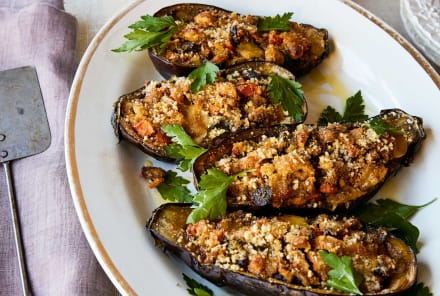Advertisement
Essential Herbs For Autumn Wellness


Autumn is about returning to our roots and going inward energetically. It's a great time for taking stock of our life and our health, dialing back the sun-fueled activity of the summer, and nourishing the body in a deeper way. Ayurveda and traditional Chinese medicine encourage us to shift our diet and lifestyle along with the change of the seasons—I like to take this mindful approach one step further and take time to review which herbs I include into my seasonal routine, too.
And what better way to do this than with autumn-centered medicinal herbs? Including some immune-boosting roots and mushrooms that truly feel autumnal to use.
Just as the detoxifying bitters and leafy greens (think: nettle, dandelion leaf) signal springtime and bright edible flowers (like calendula and borage) grace your summer diet, the fall season also has traditional botanicals that not only tend to be harvested at this time of year but also supply us with just the right nutrients and healing compounds we need to fight the health issues we encounter during autumn: like cold and flu.
Need inspiration? Here are some of my favorite fall season herbs to include in your food, in teas, and as medicines.
Medicinal mushrooms: I like to include more medicinal mushrooms into my diet and my herbal remedies at this time of year—shiitake mushrooms are especially nice (not all the medicinal mushrooms taste so delicious!) You'll find them in my immunity-boosting miso soup below. Shiitakes demonstrate antiviral activity to keep the common cold at bay. Other adaptogenic mushroom picks include reishi and chaga, which can be taken in powder, capsule, or tincture form. You can also include mushroom powders in your coffee or smoothies, or use capsules.
Burdock root: Gobo, as it is called in traditional Chinese medicinal cooking, is another fall favorite and seasonal harvest. Burdock root is rich in vitamins and minerals, and its inulin content (as is found in dandelion and elecampane root as well) is being studied for its beneficial effects on the immune system, especially in the area of the gut-associated lymphoid tissue (GALT). I love it cut into matchstick-size pieces in stir-fries, seaweed dishes, and sushi—and you can include it in a pickled vegetable recipe.
Astragalus root: A staple of traditional Chinese medicine, astragalus is a warming immunogenic herb well-suited to fall. Complex polysaccharides in astragalus act as immunomodulators while the nutrient-rich root nourishes the body deeply. Use it in powder form, tincture, or added to soups and stews (see my Immune-Boosting Soup recipe below).
Garlic: Garlic is the original super-immunity herb. Compounds in garlic boost the disease-fighting response of white blood cells when faced with viruses in the body. Garlic helps prevent sickness in the first place, lowers total duration of cold and flu, and also diminishes the severity of symptoms like headaches, fever, and sore throat. Use fresh, organic garlic and add to your recipes in the last few minutes of cooking to preserve allicin, one of its active compounds. The best way to use it is to include two to three cloves of garlic in your diet each day—in soups or fresh-pressed into salad dressings.
Elderberry: A warming herb that's a favorite with the kids and adults alike in the form of elderberry syrup, this is my go-to herb for early signs of flu. Studies have shown1 that elderberry extract can significantly shorten the duration of influenza while lowering the need for medication, when compared with placebo. My favorite way to use elderberry is in tincture or syrup form. The typical dose for this is 3 tablespoons of syrup per day for adults (3 teaspoons/day for kids > 2 years old) starting at the earliest signs of flu. Of course, if you think you have the flu, also seek appropriate medical care.
Ginger: While ginger itself is actually a tropical plant, the root (rhizome) of the ginger plant has been used for medicinal purposes for thousands of years to warm the body; beat chills; and reduce aches, pains, and digestive symptoms—accompanying colds or just more generally. Organic ginger can be used fresh or powdered. Juice it raw, add to smoothies or other recipes, or steep it as a tea (recipe below!).
To make ginger tea, use 1 tablespoon of freshly grated ginger root and steep in 2 cups of hot water, covered, for 10 minutes. Strain and add a slice of lemon and a spoonful of raw honey.
Immunity-Boosting Miso Soup

Herbal remedies have traditionally been incorporated into soups and congees. Here's the recipe for my immunity-boosting miso soup, a family favorite that's nourished us every fall. This tasty soup can be eaten by adults several times/week as a tonic and given to your child in small amounts once or twice weekly. Use it as a preventive approach to bypass colds and flu this autumn.
Ingredients:
1 yellow onion, sliced
10 shiitake mushrooms, chopped
2 large carrots, sliced
1 teaspoon fresh grated ginger
2 quarts water
2 slices dried astragalus root*
¼ teaspoon dried red ginseng slices*
1 3-inch length of codonopsis root*
¼ cup pieces of wakame or kombu seaweed
4 cloves chopped garlic
¼ cup organic red miso paste (or chickpea or other miso if you don't use soy)
Optional:
1 to 2 cups cooked rice, soba, or udon noodles to make it a ramen bowl
Slices cooked chicken breast, ½ brick cubed tofu, 1 egg cooked to your preference, per served bowl to make it a complete one-bowl meal
Method
Sauté the onion, shiitake mushrooms, carrots, and ginger. Add the water, astragalus root, ginseng, and codonopsis slices. I put them into a little stainless-steel tea ball and just remove it at the end before serving (these roots are tough and not meant to be eaten!). The soup has a slightly stronger and earthier taste than your usual miso soup. Simmer for 45 minutes, then add the cooked rice or noodles, and chopped garlic. Cook for 15 minutes more. Remove the astragalus, ginseng, and codonopsis slices. Dissolve in the miso paste. A serving is ½ to 1 cup. Will keep in the fridge and can be reheated for several days. You can add ½ brick cubed tofu or pieces of cooked chicken breast while cooking the soup, or top with an egg cooked to your taste after you've served it, if you want to make this a complete meal.
*In the United States, organic bulk herbs can be purchased in small amounts from my favorite source, Mountain Rose Herbs (I have no financial relationship with them—I just think they do a great job!).
Enjoy!
Echinacea: Echinacea root is one of the most widely used botanicals for cold and flu prevention. It's been shown to reduce both the severity and the duration of colds. Studies suggest echinacea contains active substances that support immune function. If you're someone who gets sick every flu season, take it in capsule form when cold and flu season comes around, and you might be surprised to find that you rarely get sick!
Mix It Up!
Do you take the same medicinal herbs all year long? It might be time to shake up your routine and shift your daily botanicals along with the seasons. This fall, load up on nourishing roots and immune-boosting medicinal mushrooms for a change of pace, less medication use—and a healthier season.
Watch Next
Enjoy some of our favorite clips from classes
Enjoy some of our favorite clips from classes
What Is Meditation?
Mindfulness/Spirituality | Light Watkins
Box Breathing
Mindfulness/Spirituality | Gwen Dittmar
What Breathwork Can Address
Mindfulness/Spirituality | Gwen Dittmar
The 8 Limbs of Yoga - What is Asana?
Yoga | Caley Alyssa
Two Standing Postures to Open Up Tight Hips
Yoga | Caley Alyssa
How Plants Can Optimize Athletic Performance
Nutrition | Rich Roll
What to Eat Before a Workout
Nutrition | Rich Roll
How Ayurveda Helps Us Navigate Modern Life
Nutrition | Sahara Rose
Messages About Love & Relationships
Love & Relationships | Esther Perel
Love Languages
Love & Relationships | Esther Perel











